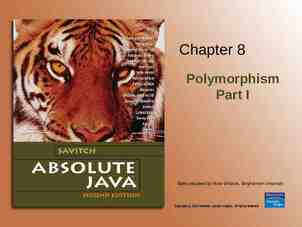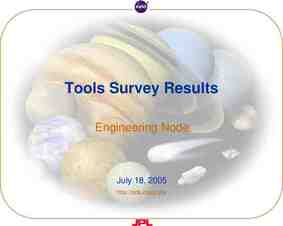DTIC Overview Mr. Gopi Nair Defense Technical Information Center
17 Slides4.60 MB
DTIC Overview Mr. Gopi Nair Defense Technical Information Center Briefing at Board on Research Data and Information (BRDI) Meeting September 24, 2009 Approved for Public Release U.S. Government Work (17 USC § 105) Not copyrighted in the U.S.
Recent DTIC Successes DTIC Online DTIC Online Access Controlled DoDTechipedia.mil DefenseSolutions.gov Open Archives Initiative Large Datasets
DTIC Online
DTIC MultiSearch: Enhanced Federated Search MultiSearch – searches more than 400 DoD, federal, commercial & international S&T sources from 50 countries
DTIC Online Access Controlled –Integrated resources for DTIC registered users with personal customization of home page
DoDTechipedia: DoD S&T Wiki for Collaboration Fosters communication between those with needs and those with answers. Any user can edit content and add attachments. 6
DoDTechipedia https://dodtechipedia.mil Launched October 2008 DoD science & technology wiki In excess of 9,000 registered users Close to 228,000 page views More than 1,000 pages added Share knowledge Connect across walls Collaborate
DefenseSolutions.gov DoD Portal for Ideas
DefenseSolutions.gov DoD Business Portal DoD’s new online access for private sector innovation To find technical solutions to battlefield challenges – Battlefield Forensics To attract technical experts, engineers, craftsmen, and inventors to submit ideas – Find good ideas & develop quickly Launched February 2009
Open Archives Initiative Value of OAI Internet search engines like Google, MSN, Yahoo, etc., provided information through OAI, brings customers to full-text document downloads and referrals. DTIC Strategic Plan: “In this era of ever-changing technology and shifting requirements, the value of central information sources, like DTIC, which acquire, organize, and disseminate information for others, becomes more apparent. Our information expertise will ensure we do our part to provide authorized access to information worldwide.” – R. Paul Ryan, Administrator
DoD Large Datasets DTIC initiated a study investigating the DoD community’s needs for establishing network services to manage DoD generated datasets. Objective: – Determine the community’s level of interest in this program – Initiate the requirements elicitation process – Outline DTIC’s proposed program on Managed Services of DoD generated RDT&E datasets 11
Rationale The volume of scientific data generated within the DoD is increasing Re-use to test hypotheses, algorithms or models Increase the value of the data by sharing with others No DoD network services available to manage datasets DTIC has taken the lead to manage DoD generated datasets DTIC will be the central coordinating point for DoD STI datasets DTIC will demonstrate new supporting technology for its applications 12
Spectrum of Possible DTIC Services Science Grid Operational Products Analytical Products Data Archive Repository of Metadata Technical Standards for Metadata Policy for Metadata/Preservation Data Linked to Reports Pointers to repositories 13
DTIC Dataset Concept Data Discovery User Dataset Registrati on Security Service Interface Discovery Agent Metadata Registrar Data Translato rs Community Datasets DTIC Managed Services Data Data Warehouse Warehouse Acquired Dataset Metadata Leveraged DoD Assets MDR Leveraged Govt Assets NOAA NASA 14
DTIC’s Role in Digital Data Life Cycle Life Cycle Phases Creation Ingestion or Acquisition Documentation Organization Migration Protection Access Disposition Role of DTIC Services for Data Preservation Identify sources of data. Identify permanent location. Establish agreements and responsibilities Establish technologies to access and search. Establish metadata. Provide visibility. Define metadata standards. Track usage and status Develop repository standards. Conform to standards Maintain awareness of dataset location and migration of data. Implement quality control, access restrictions, user authorization, and trustworthiness Catalog and describe metadata. Disseminate information about available data. Support necessary methods for discovery. Provide community support Assume ownership of orphaned data. Remove unwanted information. Based on “Harnessing the Power of Digital Data for Science and Society” Report of the Interagency Working Group on Digital Data to the Committee of the Nation Science and Technology Council January 2009 (http://www.nitrd.gov/about/Harnessing Power.aspx) 15
Program Plan We are here 16
Disclaimer of Endorsement Reference herein to any specific commercial products, process, or service by trade name, trademark, manufacturer, or otherwise, does not necessarily constitute or imply its endorsement, recommendation, or favoring by the United States Government. The views and opinions of authors expressed herein do not necessarily state or reflect those of the United States Government, and shall not be used for advertising or product endorsement purposes. 17






















